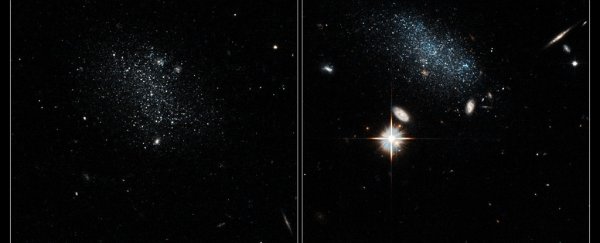Astronomers working with NASA's Hubble space telescope have spotted two dwarf galaxies known as Pisces A and B leaving a stellar void to join a denser region of space full of intergalactic gas.
Examining how the dwarf galaxies interact with the gases in their new home could help astronomers to better understand how galaxies evolve and grow as they move through the Universe.
"These Hubble images may be snapshots of what present-day dwarf galaxies may have been like at earlier epochs," said lead researcher Erik Tollerud, from the Space Telescope Science Institute in Baltimore. "Studying these and other similar galaxies can provide further clues to dwarf galaxy formation and evolution."
The team says that the two dwarf galaxies have spent most of their lives in the Local Void - a region of space that's 150 million light-years wide, and only sparely populated with other galaxies. But the whole time they were inside this Local Void, the gravitational pull of denser areas of the Universe have been tugging them closer and closer.
Now, Pisces A and B are finally ready to leave the Local Void and enter an extremely dense area of space, where the researchers expect the duo will start to rapidly grow, producing millions of stars.
This is exciting news for astronomers, because even the biggest galaxies in our Universe started their lives as dwarf galaxies. Over time, these smaller galaxies collide, forming larger and larger galaxies in the process.
Since Pisces A and B have been stuck in a void for about 100 million years, they haven't collided with anything yet, keeping them very much the same as they were when they originally formed. Basically, they're galactic time capsules.
 NASA/ESA/E. Tollerud
NASA/ESA/E. Tollerud
"These galaxies may have spent most of their history in the void," said Tollerud. "If this is true, the void environment would have slowed their evolution. Evidence for the galaxies' void address is that their hydrogen content is somewhat high relative to similar galaxies."
"In the past, galaxies contained higher concentrations of hydrogen, the fuel needed to make stars. But these galaxies seem to retain that more primitive composition, rather than the enriched composition of contemporary galaxies, due to a less vigorous history of star formation," he continued.
"The galaxies also are quite compact relative to the typical star-forming galaxies in our galactic neighbourhood."
The team was able to spot the two galaxies – which are extremely dim – by first using radio telescopes to pinpoint hydrogen clouds.
After combing through the results to differentiate what clouds were inside our galaxy and which ones might be faraway galaxies themselves, the team had 30 to 50 likely candidates.
From there, they studied these candidates even further with visual light telescopes, selecting the best two candidates for further study with Hubble's Advanced Camera for Surveys, which yielded their current results.
The team doesn't know when the galaxies will start growing and forming new stars, but will continue to examine the galaxies on their path to adulthood.
The team's report was published in The Astrophysical Journal.
